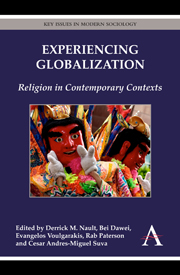Book contents
- Frontmatter
- Contents
- Preface
- Chapter 1 Introduction
- Part One Religion in Global and Transcultural Perspective
- Part Two Comparative and Pluralistic Approaches
- Part Three Religion in Taiwan
- Chapter 8 Religion in the Media Age: A Case Study of Da Ai Dramas from the Tzu Chi Organization
- Chapter 9 “Techno Dancing Gods”: Comicized Deity Images as Expressions of Taiwanese Cultural Identity
- Chapter 10 Rituals of Identity in Alid Belief: Siraya Religion in Taiwan since 1945
- List of Contributors
Chapter 10 - Rituals of Identity in Alid Belief: Siraya Religion in Taiwan since 1945
from Part Three - Religion in Taiwan
Published online by Cambridge University Press: 05 May 2013
- Frontmatter
- Contents
- Preface
- Chapter 1 Introduction
- Part One Religion in Global and Transcultural Perspective
- Part Two Comparative and Pluralistic Approaches
- Part Three Religion in Taiwan
- Chapter 8 Religion in the Media Age: A Case Study of Da Ai Dramas from the Tzu Chi Organization
- Chapter 9 “Techno Dancing Gods”: Comicized Deity Images as Expressions of Taiwanese Cultural Identity
- Chapter 10 Rituals of Identity in Alid Belief: Siraya Religion in Taiwan since 1945
- List of Contributors
Summary
Introduction
The Siraya are an Austronesian aboriginal group in Taiwan whose status is unrecognized by the Republic of China (ROC) government controlling the island. Sinification has impacted the Siraya since the beginning of Chinese rule in 1662, but accelerated after World War II and the 1949 retreat of Nationalist forces to Taiwan. In the midst of this Sinification, the Siraya revival movement in recent years has aimed at persuading the government to recognize the group's distinct ethnic identity and indigenous status.
Like other Formosan aboriginal groups, the Siraya are classified as Austronesians. Some scholars (Chaw 2001; Huang 1996; Sim 2003) believe Taiwan to be the prehistoric source of Austronesian peoples elsewhere in the Pacific. Following twentieth-century Japanese ethnography, aboriginal Formosans are divided into two main categories: Takasago-zoku (mountain tribes) and Peipo-zoku (plains tribes). The Siraya belong to the Peipo group and are divided into three subgroups: Siraya proper (or the main group of Siraya), Makattao and Teivorangh (also known as Taivoan) (Hsieh 2006). I use “Siraya” for all three, although some members of the Makattao and Teivorangh consider themselves to belong to different ethnic groups.
Although numerous records attest to the historical existence of the Siraya, the ROC government refuses to recognize contemporary Siraya either as indigenous or as a distinct ethnic group. At issue is whether the Siraya have retained enough of their culture and identity to claim continuity with their forebears, or can be considered as having assimilated to the Han. To make the case for a Siraya identity, the Siraya revival movement therefore aims to document the people's history, language and culture.
- Type
- Chapter
- Information
- Experiencing GlobalizationReligion in Contemporary Contexts, pp. 195 - 214Publisher: Anthem PressPrint publication year: 2013



